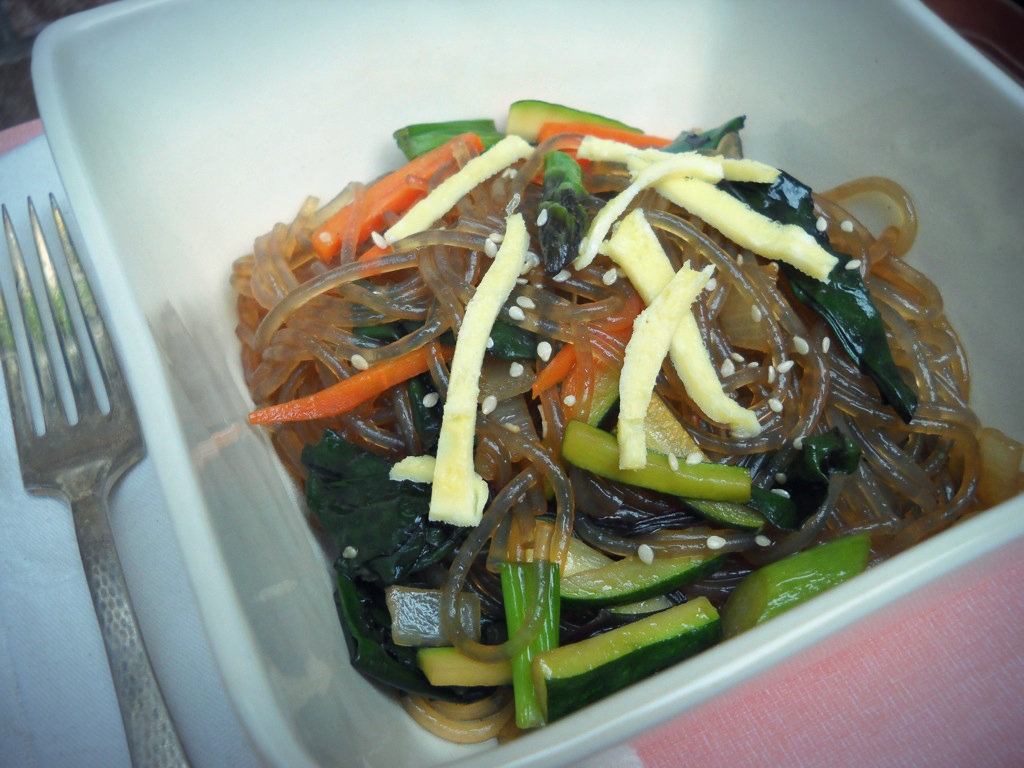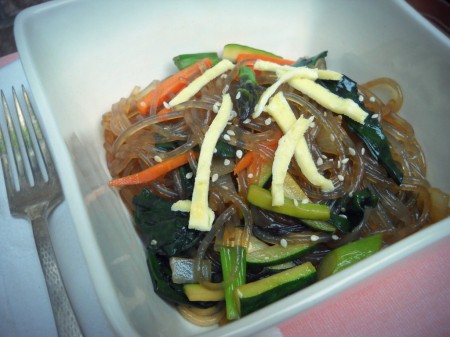I’ve been on a bit of a Korean-food bender lately. Not authentic, mind you: Unless you’re talking Jew food or maybe an Italian-American recipe from my in-laws, authenticity ain’t my thang. Flavor is.
And Korean food, hooo baby, that stuff’s got mad flavor. Especially if you like pairing salty with sweet—if you’re a fan of salted caramel, for example, and you haven’t tried Korean food, get thee to a plate of bulgogi immediately. If you like spicy food and you’re not already addicted to kimchi, well, one taste will change your life.
About a year ago I shared my “picky eater special” recipe for Korean-inspired beef lettuce wraps, and there’s a pretty awesome Korean Beef Stew in the “Big Batch Bonanza” chapter of Parents Need to Eat Too. That’s all fine. Better than fine. But the best yet, my all-time favorite Korean dish, is jap chae, which takes the salty-sweet trick to the stratosphere by combining a quick stir-fry with chewy, slippery glass noodles made from sweet potato starch. Seriously, I would eat jap chae every day. The chewy thing, it’s my weakness.
Until recently I’d never made it at home—which means I had no idea how drop-dead simple it is, or how flexible. The version I made used no beef, and swapping tofu for the egg makes it vegan. Change the vegetables to suit your crisper’s contents, as well as your family’s preferences. If you’ve ever cooked anything vaguely Asian, I can almost guarantee you’ve got the sauce ingredients in your pantry right now. And from start to finish, you’re looking at well under an hour’s kitchen time.
Just writing this post is making me crave more jap chae. It may have to be on the menu at least once a week.
Vegetable Jap Chae
Serves 2-3, doubles well (use a very large skillet)
2 tablespoons vegetable oil, divided
2 eggs, beaten
6 ounces sweet potato starch noodles (glass noodles)
2 cups mild greens, such as beet greens, chard, or spinach, roughly chopped
2 tablespoons sesame oil, divided
3 tablespoons reduced-sodium soy sauce
1 tablespoon sugar
1 small onion, chopped
2 carrots, julienned
4 asparagus spears, cut on the bias into 1” pieces
1 small clove garlic, minced
3 scallions, whites and pale green parts only, cut into 1/2” pieces
1 small zucchini, seedy center discarded, julienned
1 tablespoon sesame seeds, toasted
- Put a large pot of unsalted water on to boil, covered.
- Heat 1 teaspoon vegetable oil in a large nonstick skillet over medium heat. When it shimmers add the egg and cook, undisturbed, until firm enough to flip. Cook another minute, then remove to a plate. When cool enough to handle, roll into a tight cigar and cut into thin strips.
- Cook noodles in boiling water for 5 minutes, then add the greens. Cook another 1-2 minutes, until noodles are tender and chewy—taste one, since they’ll look cooked almost as soon as they hit the water. Drain, rinse with cold water, and drain again. Transfer to a large mixing bowl and use kitchen shears to cut the noodles into manageable pieces. (Don’t worry if you cut the greens, too!) Toss with 1 tablespoon sesame oil.
- While the noodles are cooking, combine 1 tablespoon sesame oil, the soy sauce, and the sugar in a small bowl and set aside.
- Return the large nonstick skillet to the burner over medium heat, and add the remaining vegetable oil. When it shimmers, add the onion and cook, stirring occasionally, until translucent, 2-3 minutes. Add the carrots and asparagus and cook another 1-2 minutes, until vegetables begin to soften. Add the zucchini and cook another 1-2 minutes, then add the garlic and scallions. Cook 1 minute more, then add the noodles, the greens, and the soy sauce mixture. Toss everything together until the noodles and greens are heated through.
- Serve topped with sesame seeds and egg.
MAKE BABY FOOD: Because of the soy sauce, I’d wait until baby’s a little older to serve the finished dish. Instead, stir the noodles and greens into the vegetable mixture before adding the sauce, then remove a portion for baby, along with some of the egg. If you’re serving finger food, be sure to cut the noodles and greens into small bits to prevent choking. If you’re pureeing, add a splash of broth or reserve a bit of the noodle-cooking water.

